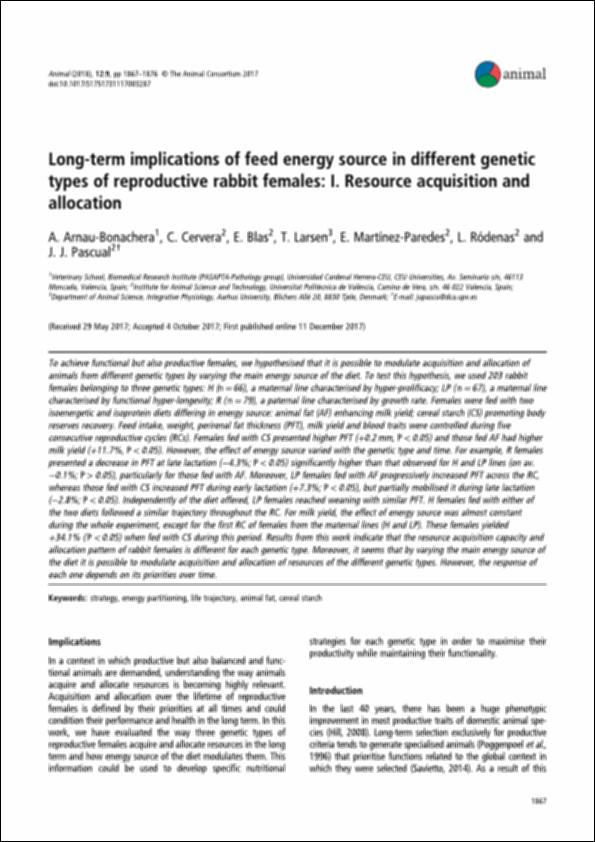Please use this identifier to cite or link to this item:
http://hdl.handle.net/10637/10496Long-term implications of feed energy source in different genetic types of reproductive rabbit females. I, Resource acquisition and allocation
| Title: | Long-term implications of feed energy source in different genetic types of reproductive rabbit females. I, Resource acquisition and allocation |
| Other Titles: | Resource acquisition and allocation |
| Authors : | Arnau Bonachera, Alberto Cervera Fras, Concha Blas Ferrer, Enrique Larsen, Torben Martínez Paredes, Eugenio Melchor Ródenas Martínez, Luis Pascual Amorós, Juan José |
| Keywords: | Grain.; Rabbits - Genetics.; Almidón.; Cereales.; Conejos - Genética.; Conejos - Alimentación.; Rabbits - Feeding and feeds.; Starch. |
| Publisher: | Cambridge University Press. |
| Citation: | Arnau Bonachera, A., Cervera, C., Blas, E., Larsen, T., Martínez Paredes, E., Ródenas, L. et al. (2018). Long-term implications of feed energy source in different genetic types of reproductive rabbit females. I, Resource acquisition and allocation. Animal, vol. 12, n. 9 (sept.), pp. 1867-1876. DOI: https://doi.org/10.1017/S1751731117003287 |
| Abstract: | To achieve functional but also productive females, we hypothesised that it is possible to modulate acquisition and allocation of animals from different genetic types by varying the main energy source of the diet. To test this hypothesis, we used 203 rabbit females belonging to 3 genetic types: H (n=66), a maternal line characterised by hyper-prolificacy; LP (n=67), a maternal line characterised by functional hyper longevity; R (n=79), a paternal line characterised by growth rate. Females were fed with 2 isoenergetic and isoprotein diets differing in energy source: animal fat (AF) enhancing milk yield; cereal starch (CS) promoting body reserves recovery. Feed intake, weight, perirenal fat thickness (PFT), milk yield and blood traits were controlled during 5 consecutive reproductive cycles. Females fed with CS presented higher PFT (+0.2mm, P<0.05) and those fed AF had higher milk yield (+11.7%, P<0.05). However, the effect of energy source varied with the genetic type and time. For example, R females presented a decrease in PFT at late lactation (4.3%; P<0.05) significantly higher than that observed for H and LP lines (on av. 0.1%; P>0.05), particularly for those fed with AF. Moreover, LP females fed with AF progressively increased PFT across the RC, whereas those fed with CS increased PFT during early lactation (+7.3%; P<0.05), but partially mobilised it during late lactation (-2.8%; P<0.05). Independently of the diet offered, LP females reached weaning with similar PFT. H females fed with either of the two diets followed a similar trajectory throughout the RC. For milk yield, the effect of energy source was almost constant during the whole experiment, except for the first reproductive cycle of females from the maternal lines (H and LP). These females yielded +34.1% (P<0.05) when fed with CS during this period. Results from this work indicate that the resource acquisition capacity and allocation pattern of rabbit females is different for each genetic type. Moreover, it seems that by varying the main energy source of the diet it is possible to modulate acquisition and allocation of resources of the different genetic types. However, the response of each one depends on its priorities over time. |
| Description: | Este artículo se encuentra disponible en la siguiente URL: https://www.sciencedirect.com/science/article/pii/S1751731117003287?via%3Dihub |
| URI: | http://hdl.handle.net/10637/10496 |
| Rights : | http://creativecommons.org/licenses/by-nc-nd/4.0/deed.es |
| ISSN: | 1751-732X (Electrónico). 1751-7311 |
| Issue Date: | 1-Sep-2018 |
| Center : | Universidad Cardenal Herrera-CEU |
| Appears in Collections: | Dpto. Producción y Sanidad Animal, Salud Pública Veterinaria y Ciencia y Tecnología de los Alimentos |
Items in DSpace are protected by copyright, with all rights reserved, unless otherwise indicated.


